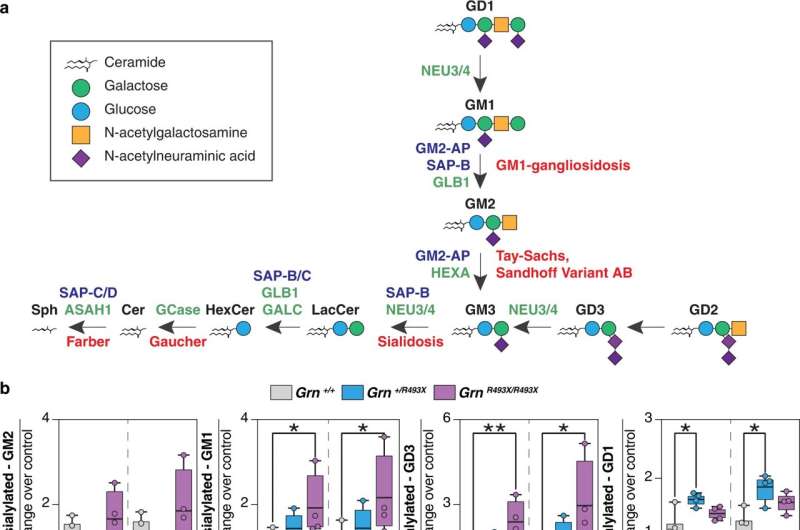
Dementia encompasses a range of neurodegenerative conditions that lead to memory loss and cognitive deficiencies and affect some 55 million people worldwide. Yet despite its prevalence, there are few effective treatments, in part because scientists still don’t understand how exactly dementia arises on a cellular and molecular level.
Now, a team led by scientists at Harvard Medical School and Harvard T. H. Chan School of Public Health has made progress in unraveling the mechanism underlying a type of dementia that strikes early in life.
In a study published Oct. 7 in Nature Communications, researchers discovered that a genetic form of frontotemporal dementia (FTD) is associated with accumulation of specific lipids in the brain—and this accumulation results from a protein deficiency that interferes with cell metabolism.
The results, based on experiments in human brain cells and in animal models, provide new insights into FTD that could inform the design of new therapies. Additionally, the findings highlight a mechanism of metabolic disruption that may be relevant in other forms of neurodegeneration, the researchers said.
A black box
There are several different types of dementia, each with complicated genetics that involve various mutations. FTD, characterized by a loss of cells in the frontal and temporal lobes of the brain, accounts for 5 to 10 percent of dementia cases. Often diagnosed in patients between 45 and 65 years old, the genetic forms tend to cluster in families. Around 15 percent of the time, FTD is linked to a specific mutation in the GRN gene, which causes brain cells to stop making a protein called progranulin.
Previous studies have linked progranulin to parts of the cell called lysosomes, which are responsible for cleanup and other metabolic activities in cells. However, “the function of the protein, including its role in the lysosome, has remained sort of a black box,” said co-senior author Wade Harper, the Bert and Natalie Vallee Professor of Molecular Pathology in the Department of Cell Biology in the Blavatnik Institute at HMS.
Harper collaborated on the study with co-senior authors Tobias Walther and Robert Farese Jr., who were professors of cell biology at HMS and professors of molecular metabolism at Harvard Chan School when they conducted the research, as well as lead authors Sebastian Boland, a former research fellow in the Farese & Walther Lab, and Sharan Swarup, a former research fellow in the Harper lab.
The researchers initially found that progranulin-deficient human cell lines and mouse brains, as well as brain cells from patients with FTD, had an accumulation of gangliosides—lipids commonly found throughout the nervous system.
Next, the team used recently developed technology for purifying lysosomes to analyze the types and amounts of proteins and lipids present inside them. Using this technique, the scientists found that lysosomes in these cells and tissues from brains with FTD had reduced levels of progranulin, as well as lower-than-normal levels of a lipid called BMP, which is required to break down gangliosides, the lipids commonly found in the central nervous system. However, when researchers added BMP to cells, they observed that these cells accumulated far lower levels of gangliosides.
Together, the findings suggest that progranulin in lysosomes helps maintain the BMP levels needed to prevent gangliosides from accumulating in brain cells—buildup that may contribute to FTD.
“We’ve uncovered a role for progranulin in supporting proper degradation of gangliosides,” while also showing that it may be possible to correct the problem, Farese said.
“People are already working on treatments that involve giving patients a source of progranulin, and our results are consistent with that approach potentially being therapeutically beneficial,” Walther added. Moreover, it may be possible to develop therapies that focus on replacing BMP rather than progranulin, he said, and thus target a different part of the mechanism.
The researchers also think that a similar lysosome-based mechanism could be relevant for neurodegenerative diseases beyond FTD—an idea that they note is rapidly gaining ground in the field.
“The lysosome may be a key feature of many kinds of neurodegenerative diseases—but these diseases likely all connect with the lysosome in different ways,” Harper said. For example, scientists already know that a protein implicated in a genetic form of Parkinson’s disease controls aspects of lysosomal function. More research is needed, Farese added, to understand precisely how various lipids and proteins interact with lysosomes within the context of different neurodegenerative diseases.
Now, the researchers are studying several genes linked with lysosomal function, including genes associated with lysosomal storage diseases, to find connections between them. A central remaining question is how progranulin elevates BMP levels in the brain. Additional studies are needed to further elucidate the steps of the mechanism the team uncovered and to explain how lipid accumulation translates into cognitive decline.
Source: Read Full Article
